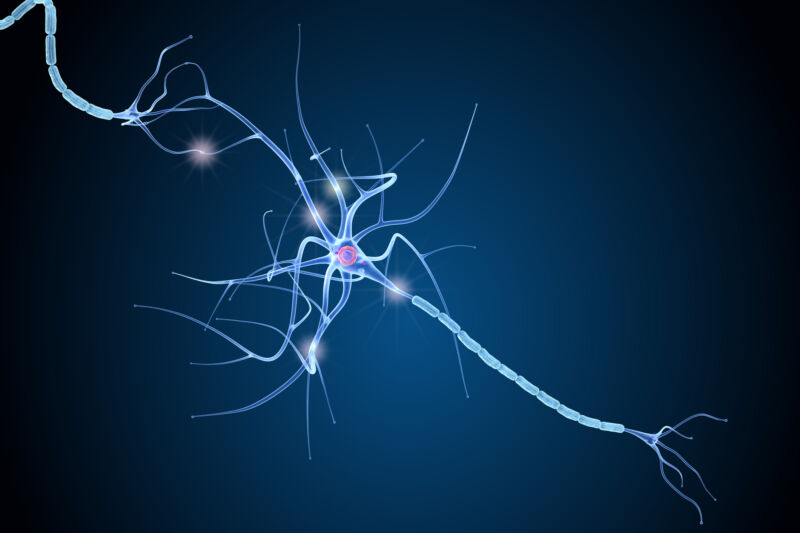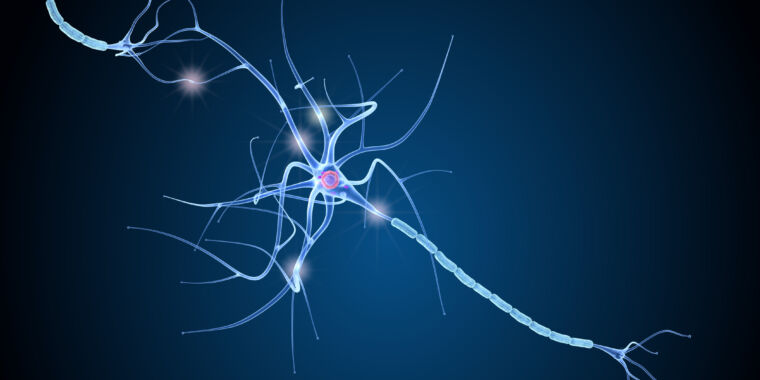DNA parasite now plays key role in making critical nerve cell protein
Domesticated viruses —
An RNA has been adopted to help the production of myelin, a key nerve protein.

Human brains (and the brains of other vertebrates) are able to process information faster because of myelin, a fatty substance that forms a protective sheath over the axons of our nerve cells and speeds up their impulses. How did our neurons evolve myelin sheaths? Part of the answer—which was unknown until now—almost sounds like science fiction.
Led by scientists from Altos Labs-Cambridge Institute of Science, a team of researchers has uncovered a bit of the gnarly past of how myelin ended up covering vertebrate neurons: a molecular parasite has been messing with our genes. Sequences derived from an ancient virus help regulate a gene that encodes a component of myelin, helping explain why vertebrates have an edge when it comes to their brains.
Prehistoric infection
Myelin is a fatty material produced by oligodendrocyte cells in the central nervous system and Schwann cells in the peripheral nervous system. Its insulating properties allow neurons to zap impulses to one another at faster speeds and greater lengths. Our brains can be complex in part because myelin enables longer, narrower axons, which means more nerves can be stacked together.
The un-myelinated brain cells of many invertebrates often need to rely on wider—and therefore fewer—axons for impulse conduction. Rapid impulse conduction makes quicker reactions possible, whether that means fleeing danger or capturing prey.
So, how do we make myelin? A key player in its production appears to be a type of molecular parasite called a retrotransposon.
Like other transposons, retrotransposons can move to new locations in the genome through an RNA intermediate. However, most retrotransposons in our genome have picked up too many mutations to move about anymore.
RNLTR12-int is a retrotransposon that is thought to have originally entered our ancestors’ genome as a virus. Rat genomes now have over 100 copies of the retrotransposon.
An RNA made by RNLTR12-int helps produce myelin by binding to a transcription factor or a protein that regulates the activity of other genes. The RNA/protein combination binds to DNA near the gene for myelin basic protein, or MBP, a major component of myelin.
“MBP is essential for the membrane growth and compression of [central nervous system] myelin,” the researchers said in a study recently published in Cell.
Technical knockout
To find out whether RNLTR12-int really was behind the regulation of MBP and, therefore, myelin production, the research team had to knock its level down and see if myelination still happened. They first experimented on rat brains before moving on to zebrafish and frogs.
When they inhibited RNLTR12-int, the results were drastic. In the central nervous system, genetically edited rats produced 98 percent less MBP than those where the gene was left unedited. The absence of RNLTR12-int also caused the oligodendrocytes that produce myelin to develop much simpler structures than they would normally form. When RNLTR12-int was knocked out in the peripheral nervous system, it reduced myelin produced by Schwann cells.
The researchers used a SOX10 antibody to show that SOX10 bound to the RNLTR12-int transcript in vivo. This was an important result, since there are lots of non-coding RNAs made by cells, and it wasn’t clear whether any RNA would work or if it was specific to RNLTR12-int.
Do these results hold up in other jawed vertebrates? Using CRISPR-CAS9 to perform knockout tests with retrotransposons related to RNLTR12-int in frogs and zebrafish showed similar results.
Myelination has enriched the vertebrate brain so it can work like never before. This is why the term “brain food” is literal. Healthy fats are so important for our brains; they help form myelin since it is a fatty acid. Think about that next time you’re pulling an all-nighter while reaching for a handful of nuts.
Cell, 2024. DOI: 10.1016/j.cell.2024.01.011
DNA parasite now plays key role in making critical nerve cell protein Read More »
